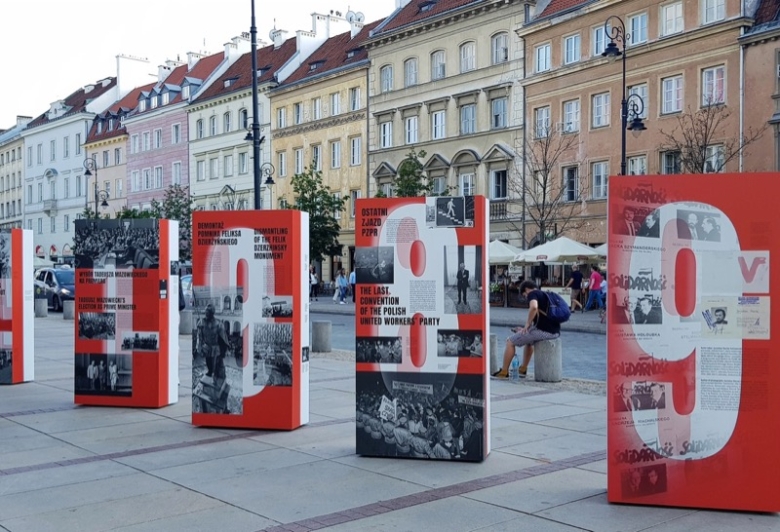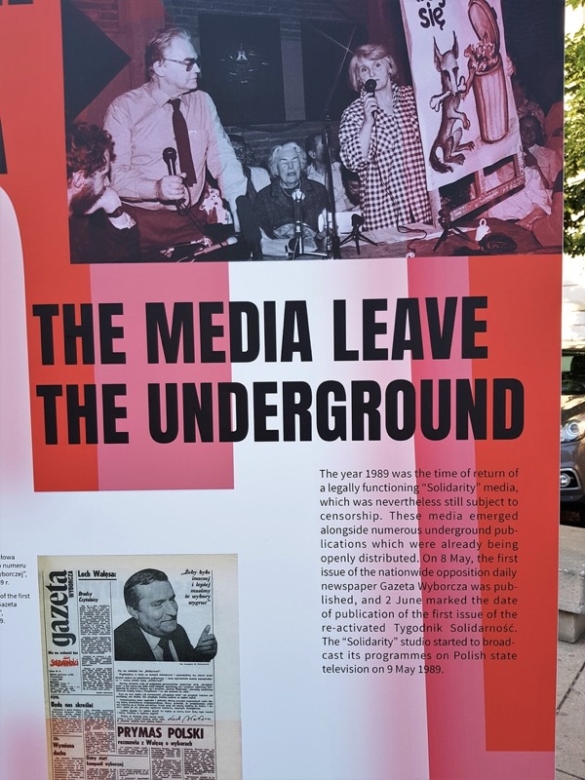Journalists from Central and Eastern Europe discuss critical issues of religion in the news
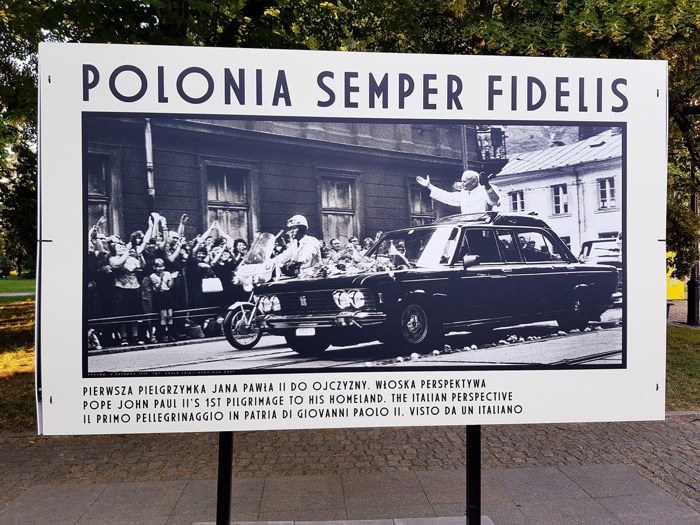
WARSAW, Poland, June 13-14, 2019—Journalists from Central and Eastern Europe gathered in Warsaw for a conference exploring coverage of faith issues in public life, politics and history in the region, organized by the International Association of Religion Journalists (IARJ).
The conference, called Journalism and Religion in Central and Eastern Europe, was attended by 30 participants. The timely issues they discussed included:
- Journalistic treatment of religious and cultural minorities;
- Coverage of migration, religion and politics;
- Reporting on the Vatican and the Roman Catholic Church, and on Orthodox Churches;
- Counteracting hate speech and fake news.
The conference included IARJ representatives from Western Europe, North America and the Maghreb, along with a scholars from the region. It was hosted by the Faculty of Journalism, Information and Book Studies of the University of Warsaw (UW) https://www.wdib.uw.edu.pl/en/home.
What follows is a sampling of images and comments from major sessions within the conference.

Religious And Cultural Diversity:
Cover Minorities While Reporting On Majorities
Among the comments at this session:
Philosopher Stanislaw Krajewski, co-chief of the Polish Council of Christians and Jews, argued that there are many kinds of minorities; probably each of us belongs to one. It’s impossible to take all into account.
According to him, even if we identify minorities to be taken into account, it is natural to have the majority in the back of one’s head, and to accept the dominant, usually majority-serving, norms.
Krajewski, who is co-author of the post-war section of the core exhibition in the Museum of History of Polish Jews POLIN https://www.polin.pl/en, also reflected on the political impact of the coverage of minorities, and what taboos, if any, are lifted.
Zuzana Kepplová of Slovakia, a journalist with newspaper SME https://www.sme.sk/, explained that in her country religion is often understood as tied to ethnicity, to national heritage which should not be shared with Romas.
Kepplová illustrated her point with a story that the newspaper ran about empty churches in Gemer, a region with poor infrastructure and lacking services. We decided to tell the story of priests who get melancholic as churches get renovated and turned into potential tourist sites while they are losing believers. They only meet Romas
she said.for baptism and funeral
,
Reporting on Refugees, Islam and European and National Politics
Among the comments at this session:
Karol Wilczyński of Poland, a journalist with Catholic website DEON https://www.deon.pl/ and co-creator with his wife Anna of https://islamistablog.pl/, posed the question if, regarding the so-called “migration crisis” started in Europe in 2015, is it enough to be the voice for the voiceless. He noted than since 2015 anti-Islamic and anti-refugee sentiments are on the rise in Poland,
whereas Muslims and refugees themselves are barely present in Polish society. Wilczyński argued that being
.the voice for the voiceless
—meaning: Muslims and refugees—may still not be enough to report in an unbiased way and break the polarizing dichotomy between for
and against
Viktória Serdült of Hungary, a journalist with HVG https://hvg.hu/, summarized the situation in her country this way: Reporting on refugees and Islam in Hungary is reporting against the currents. Such currents can be two-fold: first, it’s the lack of resources; secondly it’s Government control of the media. And as in most cases, the two are interconnected.
According to Serdült, because of the lack of funding, the number of first-hand accounts of refugee issues, Islam and international politics, have decreased,
and news coming from Government-controlled media outlets offer news reports influenced by anti-migration, anti-Islam and anti-European Union rhetoric of the governing party.
Joanna Szylko-Kwas, a scholar in the Faculty of Journalism at the University of Warsaw, presented her analysis of coverage of refugees by Polish daily press, with special attention to the function of photography. She recalled how in Poland this issue is all the more common since it constitutes an element of the ongoing dispute between the governing party and the opposition, and more importantly, between the Polish government and the European Union.
Szylko-Kwas concluded that the level of emotions related to the presented topic periodically increases, especially when there are some new related occurrences, only to drop later, yet it never dies out completely.
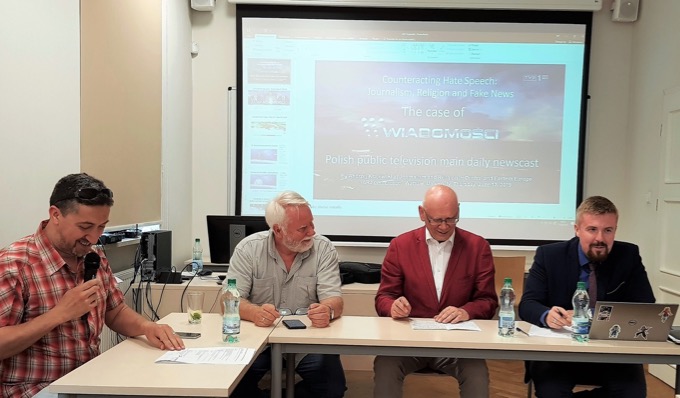
Counteracting Hate Speech:
Journalism, Religion and Fake News
Among the comments at this session:
Adam Szostkiewicz, a journalist with Polish newspaper Polityka https://www.polityka.pl/TygodnikPolityka, raised the issue of hate speech in the field of religion by discussing a number of examples dealing with Jews, Islam and the Roman Catholic Church in Poland. He argued that there is no quick solution because these are very emotional and divisive issues in public perception.
Szostkiewicz also noted that a concerted effort by all sorts of institutions which are supposed to deal with these issues, including public and church authorities, as well as public media, may be desperately needed to tackle the problem
.
Andrzej Krajewski of Poland, a TV journalist who focuses on free speech, presented an analysis on Wiadomości, a daily newscast in Polish television that airs during prime time at 7:30 pm. He stated that 75% of Wiadomości titles were of evaluation character instead of informative one.
Krajewski explained that the activities of the authorities were described with words such as: reform, strong, hero, help, sovereign,
whereas the activities of the opposition were described by words such as: scandalous, shocking, provocative, arrogance, coup d’état, embarrassing, escalation, savagery
.
Tomasz Gackowski, a scholar in the Laboratory of Media Studies https://www.lbm.uw.edu.pl/en/ at the University of Warsaw, stated that hate speech as a fatal phenomenon of present days seems to affect almost everybody.
He noted that the web seems to be not only a space of freedom and interaction, but also a great environment for hate speech,
and he elaborated on the dangers posed in the internet by fake news and deep fakes. Gackowski argued that in the present times of post-truth and post-politics defined by Baumann, for many people the truth isn’t a value which we should take care of, but the thing to challenge or even to mislead.
Reporting on the Vatican and the Roman Catholic Church
Among the comments at this session:
Paweł Bravo of Poland, a journalist with Catholic weekly Tygodnik Powszechny https://www.tygodnikpowszechny.pl/, said that many things have changed in Poland over the last 30 years, but not the attitude of the Catholic Church towards journalists.
According to Bravo, the behaviour of Polish bishops towards journalists is frozen in the 1980s, they don’t even organize real press conferences, and they treat us as enemies.
He claimed that he and his colleagues have to rely heavily on personal contacts for interesting stories, and to call sources in the Vatican who were active there during the pontificate of Polish Pope John Paul II.
Saulena Žiugždaitė of Lithuania, a journalist who contributes to Catholic online daily Bernardinai http://www.bernardinai.lt/, argued that the era of Pope Francis opened a golden age for the Catholic media, encouraging journalists to do their job well and expressing a strong stand for transparency in the Church, particularly on issues of sexual abuse, abuse of power and financial transactions.
She explained how Bernardinai, which was founded by the Franciscans in 2004, periodically struggles for financing. The local Catholic Church expects us to be a part of its PR apparatus in the ideological war; it took time for both the hierarchy and lay readers to understand the nature of journalism,
she concluded.
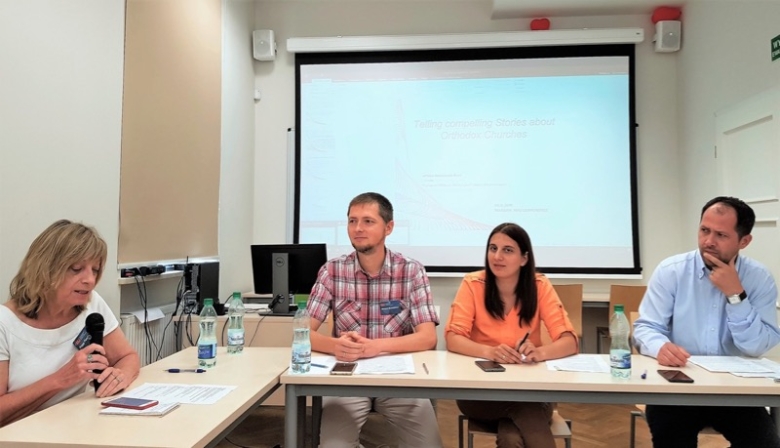
Telling Compelling Stories about Orthodox Churches
Among the comments at this session:
Jelena Jorgačević Kisić of Serbia, a journalist with Vreme https://www.vreme.com/, discussed obstacles and challenges while writing about the Orthodox Church. She noted that reporting on Orthodoxy often emphasizes its mystical, exotic aspects and replicates stereotypes. She argued that while this mystical image can be attractive for audience and thus for journalist to
Jorgačević Kisić also addressed the stance of the Serbian Orthodox Church towards media, and elaborated on use
it, it fails to provide the accountable information, to deepen the understanding and to provide reliable context.its closeness, due not just to
regular
tension between media and churches but also to historical background.
Ciprian Dumea of Romania, a journalist with public broadcaster TVR http://www.tvr.ro/, talked about the recent trip of Pope Francis to his home country, which he covered following him closely during three days, meeting the main three denominations: Orthodox, Roman Catholic and Greek Catholic. Before that, I was determined to lay out stories in which I felt discriminated confessional, both in society and especially at the workplace, where I am the only Catholic in a religious program editorial with ten people,
he said. According to Dumea, the days spent by Pope Francis in Romania were for our entire society a sort of cohabitation lesson.
Maksym Balaklytskyi of Ukraine, a journalist with Nadiia TV, explained that the Orthodox Church in Ukraine used to be perceived as a substitute of missing statehood, a symbol of
He said that, as of a study in 2018, 71.7% Ukrainians declared themselves believers, and 67.3% identified as Orthodox. Ukrainness
.In 2018, Tomos, the document by Constantinople Patriarch Bartholomew endorsing self-governance for Ukrainian Orthodox Church, was named as the main neologism of the year in the Ukrainian media,
said Balaklytskyi. He also elaborated on how Tomos became an issue for politicians as part of the ongoing conflict with Russia.
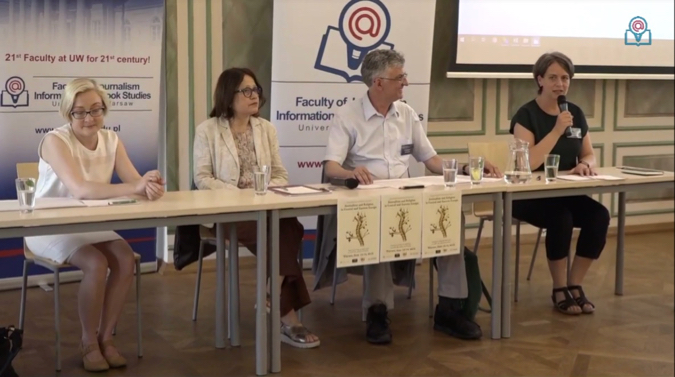
Public Session:
From Solidarity Forward
Within the IARJ conference, there was also a session open to the public, sponsored by the Association of Religion Data Archives (ARDA), http://www.thearda.com/, under the title From Solidarity forward: The tangled web of religion, history and politics in Eastern Europe. This session was streamed online and can be watched here: https://theiarj.org/blog/2019/06/13/view-arda-and-iarj-public-forum-in-warsaw-on-religion-in-eastern-europe/
Among the comments at this session:
Polish scholar Christopher Garbowski, of Maria Curie-Skłodowska University https://www.umcs.pl/en/, focused on some social currents affecting religion in Poland. Religion was an essential force in augmenting the spirit of resistance to the totalitarian communist regime for Poles—not the least in the Solidarity movement of the 1980s,
he said. Garbowski added that it is less known that the communists were against the family almost to the same degree that they opposed religion,
while the Catholic Church supported it. Among other issues about present Poland, Garbowski noted how a predominantly Catholic society has such a low birth rate.
He also argued that, if religious practice has decreased among younger Poles, under the new circumstances religion has to a larger extent become a matter of personal choice rather than received tradition, and a deeper religiosity of a significant percentage of these Poles is also evident.
Bulgarian scholar Ina Merdjanova, senior researcher and adjunct assistant professor in religious studies at the Irish School of Ecumenics, Trinity College Dublin https://www.tcd.ie/ise/, explored religion, conflict and peacebuilding in the Balkans. She framed the region as a place where four major religious traditions—Orthodox Christianity, Roman Catholicism, Judaism and Islam—have coexisted and interacted for centuries.
Merdjanova recalled oppression of religions under communist secularist regimes, and how afterwards there was a return
of religion in the public sphere. While the wars in ex-Yugoslavia were by no means religious wars, religion was implicitly involved in deepening social divisions and exacerbating tensions,
she argued. Merdjanova noted that since then, interreligious dialogue has become a central tool in the continuous international efforts to promote peaceful coexistence.
Malgorzata Glowacka-Grajper, a sociologist and social anthropologist, assistant professor at the Institute of Sociology, University of Warsaw http://www.is.uw.edu.pl/pl/english/, presented the memory landscape and memory activism of local communities where state institutions have created national memorials concerning Polish history of the 20th century. The analysis of field research found that local, traditional ways of commemoration embedded in the religious language and symbols are often not recognized as important by people outside of these communities and even ignored by them.
Glowacka-Grajper argued that, depending on the situation, local memory activism based on the religious way of thinking about victimhood collide or connects with the historical politics of the Polish state based on the changing images of the national martyrs and heroes.
IARJ Representatives
The IARJ representatives in this meeting, who acted as moderators of the various panels and as facilitators of the final workshop, were:
- IARJ international chair Douglas Todd of Canada, religion writer with the Vancouver Sun https://vancouversun.com/;
- Peggy Fletcher Stack of the United States, religion writer for the Salt Lake Tribune https://www.sltrib.com/;
- Astrid Dalehaug Norheim of Norway, editor at Dagen https://www.dagen.no/;
- Elisa Di Benedetto of Italy, freelance journalist;
- Larbi Megari of Algeria, TV journalist;
- and the author of this article, María-Paz López of Spain, foreign correspondent and religion columnist with La Vanguardia https://www.lavanguardia.com/, who served as chairwoman of the conference.
Janusz Adamowski, dean of the Faculty of Journalism, opened the works on the first day.
Remembering Sasa Milosevic
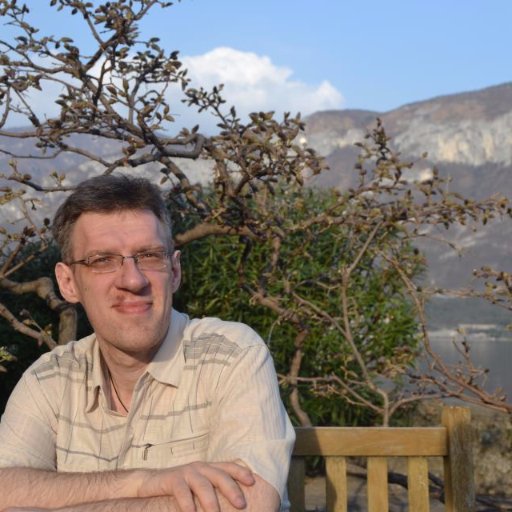
Within the conference, there was a touching moment of remembrance for Sasa Milosevic, a Serbian journalist and devoted founding member of the IARJ who died in December 2018.
Peggy Fletcher Stack, who worked with Sasa in a crossborder story years ago, evoked his memory.
She also shared some moving words sent American journalist David Briggs, who knew Sasa well and had extensive conversations with him.
Conference Sponsors
The conference Journalism and Religion in Central and Eastern Europe was financially possible thanks to the generous support of three American donors: the Kem C. Gardner Policy Institute https://gardner.utah.edu/, the Sam & Diane Stewart Family Foundation http://www.stewartfamilyfoundation.org/#the-stewart-family-foundation , and the Clark and Christine Ivory Family Foundation.
The objectives of this Warsaw meeting related to the general goals of the European Academy of Religion (EuARe) https://www.europeanacademyofreligion.org/, an European platform for research, communication and exchange on religious topics in universities and society, of which the IARJ is an active member.
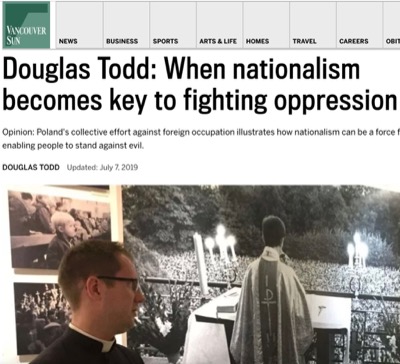
Care for More?
CHECK OUT THE CONFERENCE ON TWITTER—More info about the conference can be traced in Twitter using the hashtag #IARJWarsaw
DOUGLAS TODD published a column in the Vancouver Post about Poland’s legacy of the Solidarity movement.
And More from the Streets of Warsaw…
This year, 2019, is also the 30th anniversary of the collapse of Communism across much of Eastern Europe. While our participants were in Warsaw, historic details of that era were on display in central Stare Miasto-Old Town along central Krakowskie Przedmieście.
